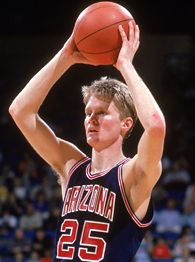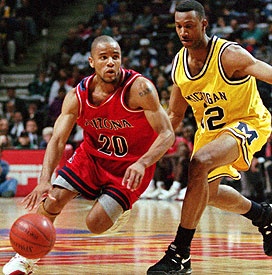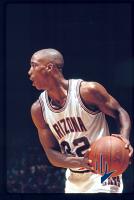Recruiting
Despite the fact that Arizona is currently on a 5-game winning streak, I’m still taking a break from focusing on the current season to looking ahead to the intriguing possibilities that will play out during the off-season. Last week I talked about the fact that whoever Olson’s successor is, they will need to possess a program first mentality. Otherwise more than just the style of play will be transformed at Arizona.
Under Lute Olson, the program has been a family organization with the focus on the players’ development and the program’s success. Olson avoided recruiting players who were out to serve their own needs, and who were going along with their own agenda before the programs. The result has been a classy program that has thrived at the top of the conference for nearly 25 years thanks to Olson’s savvy recruiting combined with only taking players who are there to play for the program.
If a coach fails to integrate the “team first” mentality into his recruiting, I fear that Arizona will no longer be the dominant program it has been, but will transform into an average program similar to ASU or USC. A program with more average years than down years, and more down years than great years. For that reason, I believe the second most important facet of a new coach will be their recruiting.
How and who the new coach recruits will be an early indicator about the long-term outlook for the program. When a coach strictly focuses on recruiting the top tier prospects, the program becomes a mere stepping stone for the NBA – as USC has become. The play of these top-tier recruits almost ensures that the team will be competitive within their conference, and perhaps even on a national level, but landing a top tier recruit and building a team around them year-in and year-out is a sure ticket towards inconsistency.
That isn’t to say that signing the big-name recruit doesn’t have its place – they certainly have their impact and place within the scheme of the program. Afterall, if a coach strictly recruited mid-level prospects, they would find themselves in a position like Washington State – too heavily reliant upon exploiting opponents’ mistakes.

Successful recruiting is a mix of mid-level talent and top-tier prospects.
Clearly the better recruiters in the nation have found a solid mix of top-tier and middle-tier players which has led to perpetual success with no “rebuilding” years like the one Oregon is currently suffering through. This mix of mid-level and top tier recruits is an absolute must-have to building a consistent, competitive team – a tradition at Arizona that I hope to see continued. Finding the appropriate mix has more to do with the needs of the team and the personality of the players than it does how many of the top tier vs. middle-tier players which are recruited.
I, for one, firmly believe that the most vital aspect of recruiting is finding the mid-level players with a lot of potential or that have been undervalued. Some of the more notable players at Arizona – Sean Elliott, Steve Kerr, Gilbert Arenas, and Jordan Hill – have come from this group of prospects. There have also been solid role players – A.J. Bramlett, Bennett Davison to name two of the more prominent ones – that simply got the job done and made an impact for the team.
By focusing on these mid-level prospects the coach will have recruited at the worst a solid bench and group of role players, and at the best a few surprise players who develop into future stars. Best-case scenario and worst-case scenario aside one thing is certain, drawing out the best talent in the middle tier of prospects while signing a top tier recruit or two every few years will lead to consistency within the program.
In direct regards to the situation at Arizona, the right coach will be capable of staving off a rebuilding effort and accomplish a transition period instead. With a rebuilding effort the entire program will essentially be scrapped and in the basement before it is restored. Considering Arizona’s consecutive NCAA Tournament streak is still active, the ’08-’09 ‘Cats are making a strong second half push, and Arizona has some surprise players, I don’t think this will be the route we take. A transition, will simply change the style and pinache’ of the team. There will be a down year or two as the new coach recruits the players to fit their game plan and builds the new traditions, but it will be more about building upon than rebuilding.
 There hasn’t been this much drama in the Arizona/Arizona State Rivalry since some audacious ASU fans’ horrendous chants towards Steve Kerr back in 1984. Yes, even more drama than last year when Arizona State seemed to turn the tables by sweeping the ‘Cats. More drama than in 1998 when Arizona left Tempe with a 1-point victory. More dramatic than when ASU won three straight between 1994 and 1995 – their longest during the Lute Olson era in Tucson – to which Arizona responded with 11-straight wins over the Sun Devils.
There hasn’t been this much drama in the Arizona/Arizona State Rivalry since some audacious ASU fans’ horrendous chants towards Steve Kerr back in 1984. Yes, even more drama than last year when Arizona State seemed to turn the tables by sweeping the ‘Cats. More drama than in 1998 when Arizona left Tempe with a 1-point victory. More dramatic than when ASU won three straight between 1994 and 1995 – their longest during the Lute Olson era in Tucson – to which Arizona responded with 11-straight wins over the Sun Devils. After trimming down roughly 25 years of rosters into two separate 12-man rosters, I had a tougher task of combining the teams into one team and cutting half the players. The criteria of Old School and New School All-Star teams has been thrown out the window because it is time to produce the All-Time Lute Olson Team. By now you should be familiar with the criteria, but I feel it is important to reiterate one of them – that the team has to be realistically functional. I can’t have 12 backcourt players on this roster, nor can I have half of the team be frontcourt players. So I’m sure that there will be a fair deal of disagreement on who gets in and who sits out. That’s okay, once again tell me what you like and what you would change and why.
After trimming down roughly 25 years of rosters into two separate 12-man rosters, I had a tougher task of combining the teams into one team and cutting half the players. The criteria of Old School and New School All-Star teams has been thrown out the window because it is time to produce the All-Time Lute Olson Team. By now you should be familiar with the criteria, but I feel it is important to reiterate one of them – that the team has to be realistically functional. I can’t have 12 backcourt players on this roster, nor can I have half of the team be frontcourt players. So I’m sure that there will be a fair deal of disagreement on who gets in and who sits out. That’s okay, once again tell me what you like and what you would change and why.
 Shooting Guard – Damon Stoudamire:
Shooting Guard – Damon Stoudamire: